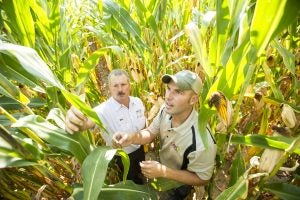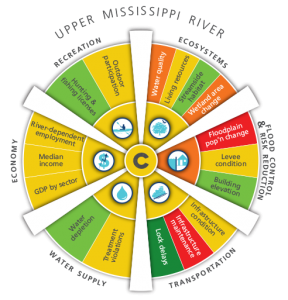The National Corn Growers Association (NCGA), which represents the interests of 300,000 U.S. corn farmers, recently approved more than a dozen climate policies as part of the policy positions its members vote on twice a year. In doing so, NCGA affirmed that climate change is real, and farmers are part of the solution. Read More
Growing Returns
Selected tag(s): NCGA
Corn farmers endorsed climate policies. Here’s what you need to know.
Four near-term market and policy opportunities for increasing agricultural resilience
Every day farmers across the U.S. face unprecedented pressures from a variety of factors, including policy and regulations, markets and trade, and variability in input costs. With extreme weather becoming a new normal and the global population climbing toward 11 billion people by 2100, it is imperative that we build a food and agriculture system that can absorb and recover from these stresses.
This summer, Environmental Defense Fund, National Corn Growers Association and Farm Journal Foundation convened a stakeholder dialogue about the challenges facing the agriculture industry and recommended paths forward.
A new white paper [PDF] summarizes key findings from the discussion, which also included ideas for better equipping farmers with the tools and incentives they need to identify and adopt climate-smart solutions.
Here are four policy and market opportunities that can help boost agricultural resilience. Read More
5 reasons why the Senate farm bill is a conservation powerhouse
The Senate votes this week on the farm bill – an $867 billion piece of legislation. Within the bill’s 1,200 pages are big advances for conservation, technology and innovation.
In addition to the bill maintaining full funding for the conservation title, here are five reasons why producers, consumers and environmentalists should celebrate the Senate farm bill and champion the inclusion of these key provisions in the House and Senate compromise bill.
Why we need a new era of collaborative conservation

This year’s Gulf of Mexico dead zone is the largest ever recorded, affecting 8,776 square miles – similar in size to the state of New Jersey.
Agriculture – from fertilizers and livestock production – is a major source of the nutrients that cause these harmful algal blooms in our lakes and coastal areas. Fertilizers are required to grow food, but we know that making farming practices more efficient and creating natural buffers and filters around farms can reduce runoff.
Farming is already risky business, with unpredictable weather, tough global competition and fluctuating commodity prices.
Implementing conservation practices at scale without hurting growers’ productivity requires understanding the challenges of different sectors and bringing together their expertise and investment. It’s a collaborative effort, and we must recognize that we are all working around a common goal: a more sustainable food system.
This month, Environmental Defense Fund is launching a series of public events – in Bozeman, St. Louis, and Des Moines – to highlight, advance, and celebrate collaborations among private landowners, food and agriculture companies, policy makers, and the public.
USDA gives big boost to sustainable farming in North Carolina
 Environmental Defense Fund’s efforts to improve sustainable farming practices through the grain supply chain received another boost, thanks to a USDA Regional Conservation Partnership Program (RCPP) grant of $500,000 in North Carolina.
Environmental Defense Fund’s efforts to improve sustainable farming practices through the grain supply chain received another boost, thanks to a USDA Regional Conservation Partnership Program (RCPP) grant of $500,000 in North Carolina.
The award supports EDF’s collaboration with Smithfield Foods, the world’s largest pork producer, and brings in university and grower organization partners. In 2014, Smithfield’s hog production division made a commitment to engage 75 percent of its grain sourcing acres, or about half a million acres, in sustainable farming practices by 2018. These practices reduce fertilizer losses to the water and air, thereby improving water quality and cutting greenhouse gas emissions.
In 2015, through a sustainability program called MBGro, Smithfield helped farmers plant cover crops, use efficient nitrogen sensors, and employ other conservation practices on nearly 100,000 acres in the Southeast. Earlier this year, the company announced the expansion of its sustainable grain program to its Midwest sourcing region with ag retailer United Suppliers.
And now, the RCPP project officially kicks off this week – and will directly engage producers to expand conservation practices in agriculture. Here’s what it entails. Read More
Collaboration can save the Mississippi River watershed
By Suzy Friedman, Director, Agricultural Sustainability, Environmental Defense Fund and Max Starbuck, Director, Market Development, National Corn Growers Association
Today, a diverse group of more than 400 businesses, associations, government agencies, science organizations, academic institutions and non-profit organizations released the first-ever report card evaluating the condition of one of our nation’s most storied and central waterways. This effort, known as America’s Watershed Initiative, was undertaken to provide information on the challenges facing the waters and lands that make up the 31-state Mississippi River Watershed and the 250 rivers that flow into it.
The overall mark was less than stellar, a D+. However, the process of grading has yielded a pathway to improvement.
Why the poor rating? The watershed continues to experience increased pressure from the demands of urbanization, agriculture, transportation and land development.
Fortunately, moving from a “D+” to an “A” grade is achievable – with new levels of understanding and collaboration. That’s why the Environmental Defense Fund and the National Corn Growers Association have a real desire to work together on this and similar initiatives. Read More











